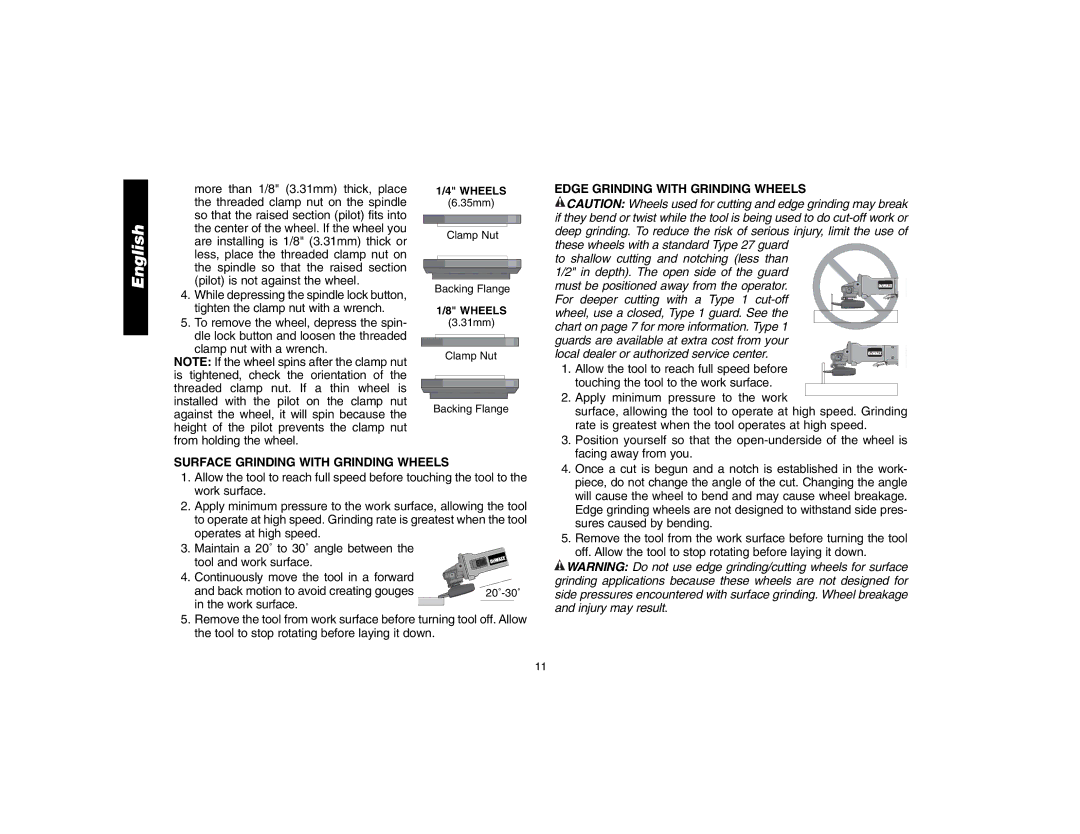
English
more than 1/8" (3.31mm) thick, place the threaded clamp nut on the spindle so that the raised section (pilot) fits into the center of the wheel. If the wheel you are installing is 1/8" (3.31mm) thick or less, place the threaded clamp nut on the spindle so that the raised section (pilot) is not against the wheel.
4.While depressing the spindle lock button, tighten the clamp nut with a wrench.
5.To remove the wheel, depress the spin-
dle lock button and loosen the threaded clamp nut with a wrench.
NOTE: If the wheel spins after the clamp nut is tightened, check the orientation of the threaded clamp nut. If a thin wheel is installed with the pilot on the clamp nut against the wheel, it will spin because the height of the pilot prevents the clamp nut from holding the wheel.
1/4" WHEELS
(6.35mm)
Clamp Nut
Backing Flange
1/8" WHEELS
(3.31mm)
Clamp Nut
Backing Flange
EDGE GRINDING WITH GRINDING WHEELS
![]() CAUTION: Wheels used for cutting and edge grinding may break if they bend or twist while the tool is being used to do
CAUTION: Wheels used for cutting and edge grinding may break if they bend or twist while the tool is being used to do
to shallow cutting and notching (less than 1/2" in depth). The open side of the guard
must be positioned away from the operator. For deeper cutting with a Type 1
chart on page 7 for more information. Type 1 guards are available at extra cost from your local dealer or authorized service center.
1. Allow the tool to reach full speed before touching the tool to the work surface.
2. | Apply minimum pressure to the work |
|
|
| |||
| surface, allowing the tool to operate at high speed. Grinding | ||
| rate is greatest when the tool operates at high speed. | ||
3. | Position yourself so that the | ||
| facing away from you. | ||
SURFACE GRINDING WITH GRINDING WHEELS
1.Allow the tool to reach full speed before touching the tool to the work surface.
2.Apply minimum pressure to the work surface, allowing the tool to operate at high speed. Grinding rate is greatest when the tool operates at high speed.
3.Maintain a 20˚ to 30˚ angle between the ![]()
tool and work surface.
4. Continuously move the tool in a forward |
|
and back motion to avoid creating gouges | |
in the work surface. |
|
5.Remove the tool from work surface before turning tool off. Allow the tool to stop rotating before laying it down.
4. | Once a cut is begun and a notch is established in the work- |
| piece, do not change the angle of the cut. Changing the angle |
| will cause the wheel to bend and may cause wheel breakage. |
| Edge grinding wheels are not designed to withstand side pres- |
| sures caused by bending. |
5. | Remove the tool from the work surface before turning the tool |
| off. Allow the tool to stop rotating before laying it down. |
![]() WARNING: Do not use edge grinding/cutting wheels for surface grinding applications because these wheels are not designed for side pressures encountered with surface grinding. Wheel breakage and injury may result.
WARNING: Do not use edge grinding/cutting wheels for surface grinding applications because these wheels are not designed for side pressures encountered with surface grinding. Wheel breakage and injury may result.
11
